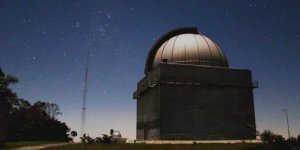| News / Space News |
Mars Spacecraft Reveal Comet Flyby Effects on Martian Atmosphere
NASA | NOVEMBER 8, 2014
Two NASA and one European spacecraft that obtained the first up-close observations of a comet flyby of Mars on Oct. 19, have gathered new information about the basic properties of the comet's nucleus and directly detected the effects on the Martian atmosphere.

This artist's concept depicts the Imaging Ultraviolet Spectrograph (IUVS) on NASA's MAVEN spacecraft scanning the upper atmosphere of Mars. ![]()
Data from observations carried out by NASA's Mars Atmosphere and Volatile Evolution (MAVEN) mission, NASA's Mars Reconnaissance Orbiter (MRO), and a radar instrument on the European Space Agency's (ESA's) Mars Express spacecraft have revealed that debris from the comet added a temporary and very strong layer of ions to the ionosphere, the electrically charged layer high above Mars.
In these observations, scientists were able to make a direct connection from the input of debris from a specific meteor shower to the formation of this kind of transient layer in response; that is a first on any planet, including Earth.
Comet C/2013 A1 Siding Spring traveled from the most distant region of our solar system, called the Oort Cloud, and made a close approach around 2:27 p.m. EDT within about 87,000 miles (139,500 kilometers) of the Red Planet. This is less than half the distance between Earth and our moon and less than one-tenth the distance of any known comet flyby of Earth.
Dust from the comet impacted Mars and was vaporized high in the atmosphere, producing what was likely an impressive meteor shower. This debris resulted in significant temporary changes to the planet's upper atmosphere and possible longer-term perturbations. Earth-based and a host of space telescopes also observed the unique celestial object.
The MAVEN spacecraft, recently arrived at Mars, detected the comet encounter in two ways. The remote-sensing Imaging Ultraviolet Spectrograph observed intense ultraviolet emission from magnesium and iron ions high in the atmosphere in the aftermath of the meteor shower. Not even the most intense meteor storms on Earth have produced as strong a response as this one. The emission dominated Mars' ultraviolet spectrum for several hours after the encounter and then dissipated over the next two days.
MAVEN also was able to directly sample and determine the composition of some of the comet dust in Mars' atmosphere. Analysis of these samples by the spacecraft's Neutral Gas and Ion Mass Spectrometer detected eight different types of metal ions, including sodium, magnesium and iron.
These are the first direct measurements of the composition of dust from an Oort Cloud comet. The Oort Cloud, well beyond the outer-most planets that surround our sun, is a spherical region of icy objects believed to be material left over from the formation of the solar system.
YOU MAY ALSO LIKE




